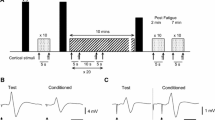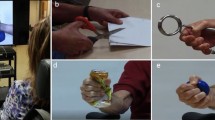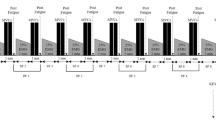Abstract
Whether reduced supraspinal activation contributes to age-related reductions in maximal torque during dynamic contractions is not known. The purpose was to determine whether there are age differences in voluntary activation and its variability when assessed with stimulation at the motor cortex and the muscle during maximal isometric, concentric, and eccentric contractions. Thirty young (23.6 ± 4.1 years) and 31 old (69.0 ± 5.2 years) adults performed maximal isometric, shortening (concentric) and lengthening (eccentric) contractions with the elbow flexor muscles. Maximal isometric contractions were performed at 90° elbow flexion and dynamic contractions at a velocity of 60°/s. Voluntary activation was assessed by superimposing an evoked contraction with transcranial magnetic stimulation (TMS) or with electrical stimulation over the muscle during maximal voluntary contractions (MVCs). Old adults had lower MVC torque during isometric (− 17.9%), concentric (− 19.7%), and eccentric (− 9.9%) contractions than young adults, with less of an age difference for eccentric contractions. Voluntary activation was similar between the three contraction types when assessed with TMS and electrical stimulation, with no age group differences. Old adults, however, were more variable in voluntary activation than young (standard deviation 0.99 ± 0.47% vs. 0.73 ± 0.43%, respectively) to both the motor cortex and muscle, and had greater coactivation of the antagonist muscles during dynamic contractions. Thus, the average voluntary activation to the motor cortex and muscle did not differ with aging; however, supraspinal activation was more variable during maximal dynamic and isometric contractions in the old adults. Lower predictability of voluntary activation may indicate subclinical changes in the central nervous system with advanced aging.






Similar content being viewed by others
Abbreviations
- ANOVA:
-
Analysis of variance
- EMG:
-
Electromyography
- MEP:
-
Motor-evoked potential
- MVC:
-
Maximal voluntary contraction
- RMS:
-
Root mean square
- SD:
-
Standard deviation
- TMS:
-
Transcranial magnetic stimulation
References
Allen GM, Gandevia SC, McKenzie DK (1995) Reliability of measurements of muscle strength and voluntary activation using twitch interpolation. Muscle Nerve 18:593–600. doi:10.1002/mus.880180605
Almuklass AM, Price RC, Gould JR, Enoka RM (2016) Force steadiness as a predictor of time to complete a pegboard test of dexterity in young men and women. J Appl Physiol 120:1410–1417. doi:10.1152/japplphysiol.01051.2015
Babault N, Pousson M, Ballay Y, Van Hoecke J (2001) Activation of human quadriceps femoris during isometric, concentric, and eccentric contractions. J Appl Physiol 91:2628–2634
Belanger AY, McComas AJ (1981) Extent of motor unit activation during effort. J Appl Physiol 51:1131–1135
Beltman JGM, Sargeant AJ, van Mechelen W, de Haan A (2004) Voluntary activation level and muscle fiber recruitment of human quadriceps during lengthening contractions. J Appl Physiol 97:619–626. doi:10.1152/japplphysiol.01202.2003
Burnett R a, Laidlaw DH, Enoka RM (2000) Coactivation of the antagonist muscle does not covary with steadiness in old adults. J Appl Physiol 89:61–71
Butler JE, Petersen NC, Herbert RD et al (2012) Origin of the low-level EMG during the silent period following transcranial magnetic stimulation. Clin Neurophysiol 123:1409–1414. doi:10.1016/j.clinph.2011.11.034
Callahan DM, Kent-Braun JA (2011) Effect of old age on human skeletal muscle force-velocity and fatigue properties. J Appl Physiol 111:1345–1352. doi:10.1152/japplphysiol.00367.2011
De Serres SJ, Enoka RM (1998) Older adults can maximally activate the biceps brachii muscle by voluntary command. J Appl Physiol 84:284–291. doi:10.1097/00005768-199705001-00069
Devanne H, Lavoie BA, Capaday C (1997) Input-output properties and gain changes in the human corticospinal pathway. Exp Brain Res 114:329–338
Dideriksen JL, Negro F, Farina D (2015) The optimal neural strategy for a stable motor task requires a compromise between level of muscle cocontraction and synaptic gain of afferent feedback. J Neurophysiol 114:1895–1911. doi:10.1152/jn.00247.2015
Doherty TJ (2003) Invited review: aging and sarcopenia. J Appl Physiol 95:1717–1727. doi:10.1152/japplphysiol.00347.2003
Duchateau J, Enoka RM (2016) Neural control of lengthening contractions. J Exp Biol 219:197–204. doi:10.1242/jeb.123158
Duclay J, Pasquet B, Martin A, Duchateau J (2011) Specific modulation of corticospinal and spinal excitabilities during maximal voluntary isometric, shortening and lengthening contractions in synergist muscles. J Physiol 589:2901–2916. doi:10.1113/jphysiol.2011.207472
Duclay J, Pasquet B, Martin A, Duchateau J (2014) Specific modulation of spinal and cortical excitabilities during lengthening and shortening submaximal and maximal contractions in plantar flexor muscles. J Appl Physiol 117:1440–1450. doi:10.1152/japplphysiol.00489.2014
Dux L (1993) Muscle relaxation and sarcoplasmic reticulum function in different muscle types. Rev Physiol Biochem Pharmacol 122:69–147
Eichelberger TD, Bilodeau M (2007) Central fatigue of the first dorsal interosseous muscle during low-force and high-force sustained submaximal contractions. Clin Physiol Funct Imaging 27:298–304. doi:10.1111/j.1475-097X.2007.00751.x
Enoka RM, Christou EA, Hunter SK et al (2003) Mechanisms that contribute to differences in motor performance between young and old adults. J Electromyogr Kinesiol 13:1–12
Gandevia SC (2001) Spinal and supraspinal factors in human muscle fatigue. Physiol Rev 81:1725–1789
Gandevia SC, Allen GM, Butler JE, Taylor JL (1996) Supraspinal factors in human muscle fatigue: evidence for suboptimal output from the motor cortex. J Physiol 490(Pt 2):529–536
Gandevia SC, Herbert RD, Leeper JB (1998) Voluntary activation of human elbow flexor muscles during maximal concentric contractions. J Physiol 512:595–602. doi:10.1111/j.1469-7793.1998.595be.x
Gribble P, Mullin L, Cothros N, Mattar A (2003) Role of cocontraction in arm movement accuracy. J Neurophysiol 89:2396–2405. doi:10.1152/jn.01020.2002
Hasan Z, Enoka RM (1985) Isometric torque-angle relationship and movement-related activity of human elbow flexors: implications for the equilibrium-point hypothesis. Exp Brain Res 59:441–450
Heckman CJ, Enoka RM (2004) Physiology of the motor neuron and the motor unit. Handb Clin Neurophysiol 4:119–147. doi:10.1016/S1567-4231(04)04006-7
Herbert RD, Gandevia SC (1999) Twitch interpolation in human muscles: mechanisms and implications for measurement of voluntary activation. J Neurophysiol 82:2271–2283
Hermens HJ, Freriks B, Disselhorst-Klug C, Rau G (2000) Development of recommendations for SEMG sensors and sensor placement procedures. J Electromyogr Kinesiol 10:361–374
Hortobágyi T, Zheng D, Weidner M et al (1995) The influence of aging on muscle strength and muscle fiber characteristics with special reference to eccentric strength. J Gerontol A Biol Sci Med Sci 50:B399-406
Hunter SK (2014) Sex differences in human fatigability: mechanisms and insight to physiological responses. Acta Physiol 210:768–789. doi:10.1111/apha.12234.Sex
Hunter SK (2016) The relevance of sex differences in performance fatigability. Med Sci Sport Exerc 48:2247–2256. doi:10.1249/MSS.0000000000000928
Hunter SK, Thompson MW, Ruell PA et al (1999) Human skeletal sarcoplasmic reticulum Ca2 + uptake and muscle function with aging and strength training. J Appl Physiol 86:1858–1865
Hunter SK, Thompson MW, Adams RD (2000) Relationships among age-associated strength changes and physical activity level, limb dominance, and muscle group in women. J Gerontol A Biol Sci Med Sci 55:B264–B273
Hunter SK, Critchlow A, Enoka RM (2004) Influence of aging on sex differences in muscle fatigability. J Appl Physiol 97:1723–1732. doi:10.1152/japplphysiol.00460.2004
Hunter SK, Butler JE, Todd G et al (2006) Supraspinal fatigue does not explain the sex difference in muscle fatigue of maximal contractions. J Appl Physiol 101:1036–1044. doi:10.1152/japplphysiol.00103.2006
Hunter SK, Todd G, Butler JE et al (2008) Recovery from supraspinal fatigue is slowed in old adults after fatiguing maximal isometric contractions. J Appl Physiol 105:1199–1209. doi:10.1152/japplphysiol.01246.2007
Hunter SK, Pereira HM, Keenan KG (2016) The aging neuromuscular system and motor performance. J Appl Physiol 121:982–995. doi:10.1152/japplphysiol.00475.2016
Inghilleri M, Berardelli A, Cruccu G, Manfredi M (1993) Silent period evoked by transcranial stimulation of the human cortex and cervicomedullary junction. J Physiol 466:521–534
Jakobi JM, Rice CL (2002) Voluntary muscle activation varies with age and muscle group. J Appl Physiol 93:457–462. doi:10.1152/japplphysiol.00012.2002
Keller ML, Pruse J, Yoon T et al (2011) Supraspinal fatigue is similar in men and women for a low-force fatiguing contraction. Med Sci Sport Exerc. doi:10.1249/MSS.0b013e318216ebd4
Kent-Braun JA, Ng AV, Doyle JW, Towse TF (2002) Human skeletal muscle responses vary with age and gender during fatigue due to incremental isometric exercise. J Appl Physiol 93:1813–1823. doi:10.1152/japplphysiol.00091.2002
Klass M, Baudry S, Duchateau J (2005) Aging does not affect voluntary activation of the ankle dorsiflexors during isometric, concentric, and eccentric contractions. J Appl Physiol 99:31–38. doi:10.1152/japplphysiol.01426.2004
Klass M, Baudry S, Duchateau J (2007) Voluntary activation during maximal contraction with advancing age: a brief review. Eur J Appl Physiol 100:543–551. doi:10.1007/s00421-006-0205-x
Klein CS, Rice CL, Marsh GD (2001) Normalized force, activation, and coactivation in the arm muscles of young and old men. J Appl Physiol 91:1341–1349
Krivickas LS, Suh D, Wilkins J et al (2001) Age- and gender-related differences in maximum shortening velocity of skeletal muscle fibers. Am J Phys Med Rehabil 80:447-455-7
Lanza IR, Towse TF, Caldwell GE et al (2003) Effects of age on human muscle torque, velocity, and power in two muscle groups. J Appl Physiol 95:2361–2369. doi:10.1152/japplphysiol.00724.2002
Larsson L, Li X, Frontera WR (1997) Effects of aging on shortening velocity and myosin isoform composition in single human skeletal muscle cells. Am J Physiol 272:C638-49
Lindle R, Metter E, Lynch N et al (1997) Age and gender comparisons of muscle strength in 654 women and men aged 20–93 year. J Appl Physiol 83:1581–1587
Macaluso A, Nimmo MA, Foster JE et al (2002) Contractile muscle volume and agonist-antagonist coactivation account for differences in torque between young and older women. Muscle Nerve 25:858–863. doi: 10.1002/mus.10113
Marmon AR, Pascoe MA, Schwartz RS, Enoka RM (2011) Associations among strength, steadiness, and hand function across the adult life span. Med Sci Sport Exerc 43:560–567. doi:10.1249/MSS.0b013e3181f3f3ab
Merton PA (1954) Voluntary strength and fatigue. J Physiol 123:553–564
Molenaar JP, McNeil CJ, Bredius MS, Gandevia SC (2012) Effects of aging and sex on voluntary activation and peak relaxation rate on human elbow flexors studied with motor cortical stimulation. Age (Omaha) 35:1327–1337. doi:10.1037/0022-3514.90.4.644
Morse CI, Thom JM, Davis MG et al (2004) Reduced plantarflexor specific torque in the elderly is associated with a lower activation capacity. Eur J Appl Physiol 92:219–226. doi:10.1007/s00421-004-1056-y
Pereira HM, Spears VC, Schlinder-Delap B et al (2015) Age and sex differences in steadiness of elbow flexor muscles with imposed cognitive demand. Eur J Appl Physiol. doi:10.1007/s00421-015-3113-0
Porter MM, Vandervoort AA, Kramer JF (1997) Eccentric peak torque of the plantar and dorsiflexors is maintained in older women. J Gerontol A Biol Sci Med Sci 52:B125-31
Pousson M, Lepers R, Van Hoecke J (2001) Changes in isokinetic torque and muscular activity of elbow flexors muscles with age. Exp Gerontol 36:1687–1698. doi:10.1016/S0531-5565(01)00143-7
Power GA, Makrakos DP, Stevens DE et al (2015) Velocity dependence of eccentric strength in young and old men: the need for speed! Appl Physiol Nutr Metab 40:703–710. doi:10.1139/apnm-2014-0543
Power GA, Minozzo FC, Spendiff S et al (2016) Reduction in single muscle fiber rate of force development with aging is not attenuated in world class older masters athletes. Am J Physiol Cell Physiol 310:C318-27. doi:10.1152/ajpcell.00289.2015
Raj IS, Bird SR, Shield AJ (2010) Aging and the force-velocity relationship of muscles. Exp Gerontol 45:81–90. doi:10.1016/j.exger.2009.10.013
Reid KF, Fielding RA (2012) Skeletal muscle power. Exerc Sport Sci Rev 40:4–12. doi:10.1097/JES.0b013e31823b5f13
Roos MR, Rice CL, Connelly DM, Vandervoort AA (1999) Quadriceps muscle strength, contractile properties, and motor unit firing rates in young and old men. Muscle Nerve 22:1094–1103
Sale D, Quinlan J, Marsh E et al (1982) Influence of joint position on ankle plantarflexion in humans. J Appl Physiol 52:1636–1642
Senefeld J, Yoon T, Hunter SK (2017) Age differences in dynamic fatigability and variability of arm and leg muscles: associations with physical function. Exp Gerontol 87:74–83. doi:10.1016/j.exger.2016.10.008
Shield A, Zhou S (2004) Assessing voluntary muscle activation with the twitch interpolation technique. Sport Med 34:253–267. doi:10.2165/00007256-200434040-00005
Simoneau J, Bouchard C (1989) Human variation in skeletal muscle fiber-type proportion and enzyme activities. Am J Physiol 257:E567–E572
Simoneau E, Martin A, Van Hoecke J (2005) Muscular performances at the ankle joint in young and elderly men. J Gerontol A Biol Sci Med Sci 60:439–447. doi:10.1093/gerona/60.4.439
Stevens JE, Stackhouse SK, Binder-Macleod S a., Snyder-Mackler L (2003) Are voluntary muscle activation deficits in older adults meaningful? Muscle Nerve 27:99–101. doi:10.1002/mus.10279
Taylor JL (2009) Point:counterpoint: the interpolated twitch does/does not provide a valid measure of the voluntary activation of muscle. J Appl Physiol 107:354–355. doi:10.1152/japplphysiol.91220.2008
Taylor JL, Butler JE, Allen GM, Gandevia SC (1996) Changes in motor cortical excitability during human muscle fatigue. J Physiol 490(Pt 2):519–528
Todd G, Taylor JL, Gandevia SC (2003) Measurement of voluntary activation of fresh and fatigued human muscles using transcranial magnetic stimulation. J Physiol 551:661–671. doi:10.1113/jphysiol.2003.044099
Todd G, Taylor JL, Gandevia SC (2004) Reproducible measurement of voluntary activation of human elbow flexors with motor cortical stimulation. J Appl Physiol 97:236–242. doi:10.1152/japplphysiol.01336.2003
Todd G, Taylor JL, Gandevia SC (2016) Measurement of voluntary activation based on transcranial magnetic stimulation over the motor cortex. J Appl Physiol. doi:10.1152/japplphysiol.00293.2016
Vandervoort AA, McComas AJ (1986) Contractile changes in opposing muscles of the human ankle joint with aging. J Appl Physiol 61:361–367
Venturelli M, Saggin P, Muti E et al (2015) In vivo and in vitro evidence that intrinsic upper- and lower-limb skeletal muscle function is unaffected by ageing and disuse in oldest-old humans. Acta Physiol (Oxf) 215:58–71. doi:10.1111/apha.12524
Wilder MR, Cannon J (2009) Effect of age on muscle activation and twitch properties during static and dynamic actions. Muscle Nerve 39:683–691. doi:10.1002/mus.21233
Yoon T, Schlinder Delap B, Griffith EE, Hunter SK (2007) Mechanisms of fatigue differ after low- and high-force fatiguing contractions in men and women. Muscle Nerve 36:515–524. doi:10.1002/mus.20844
Yoon T, De-lap BS, Griffith EE (2008) Age-related muscle fatigue after a low-force fatiguing contraction is explained by central fatigue. Muscle Nerve 37:457–466. doi:10.1002/mus.20969
Yoon T, Schlinder-Delap B, Hunter SK (2013) Fatigability and recovery of arm muscles with advanced age for dynamic and isometric contractions. Exp Gerontol 48:259–268. doi:10.1016/j.exger.2012.10.006
Yoon T, Doyel R, Widule C, Hunter SK (2015) Sex differences with aging in the fatigability of dynamic contractions. Exp Gerontol 70:1–10. doi:10.1016/j.exger.2015.07.001
Yue GH, Ranganathan VK, Siemionow V et al (1999) Older adults exhibit a reduced ability to fully activate their biceps brachii muscle. J Gerontol A Biol Sci Med Sci 54:M249–M253
Author information
Authors and Affiliations
Corresponding author
Additional information
Communicated by Nicolas Place.
Rights and permissions
About this article
Cite this article
Rozand, V., Senefeld, J.W., Hassanlouei, H. et al. Voluntary activation and variability during maximal dynamic contractions with aging. Eur J Appl Physiol 117, 2493–2507 (2017). https://doi.org/10.1007/s00421-017-3737-3
Received:
Accepted:
Published:
Issue Date:
DOI: https://doi.org/10.1007/s00421-017-3737-3




